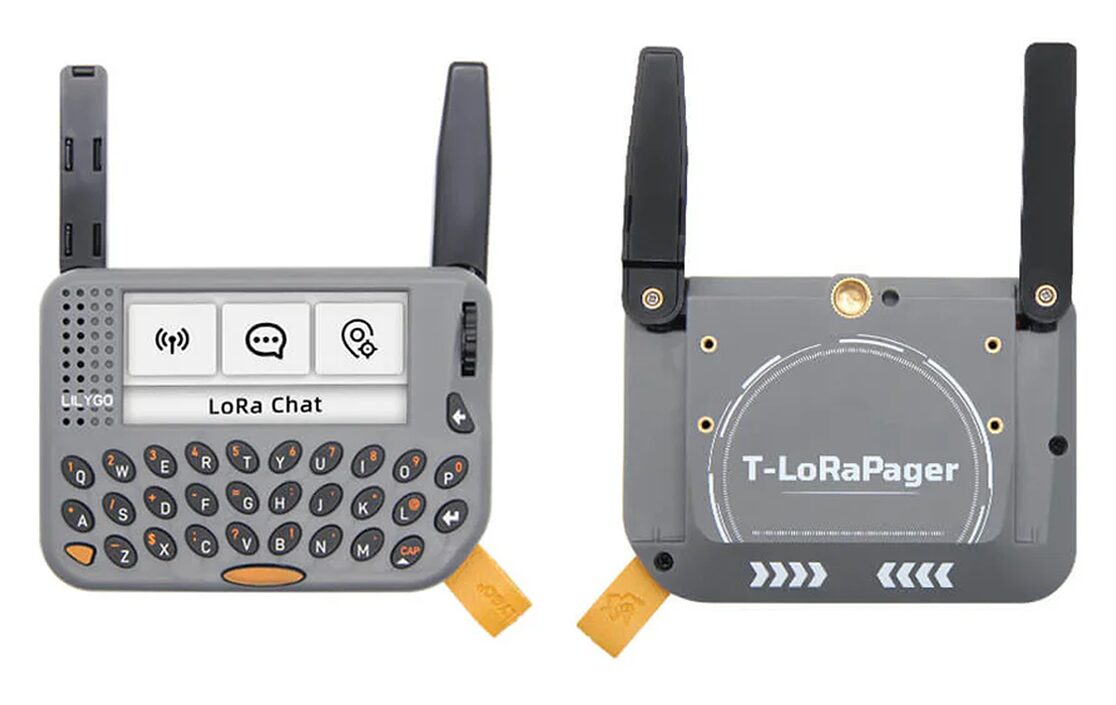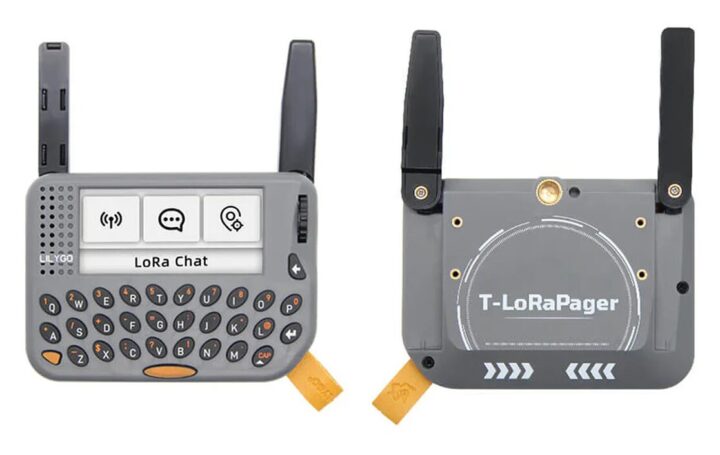LILYGO T-LoRa Pager is an ESP32-S3-based IoT handheld device that comes in an old pager form factor but relies on LoRa for text messaging, GNSS for positioning, NFC for contactless communication, and features AI-assisted motion detection with a BHI260AP IMU sensor.
The device also includes a 2.33-inch IPS display (480×222), a QWERTY keyboard, a rotary encoder, an audio codec, a microSD slot, a battery management system, and a wireless charging pad. These features make this device suitable for portable, remote sensing, asset tracking, field communication, and edge AI projects, where GNSS, LoRa, and/or NFC functionalities are required.
LILYGO’s T-LoRa Pager specifications:
Wireless SoC – Espressif Systems ESP32-S3
CPU – Dual-core 32-bit LX7 processor running at 240 MHz
Memory – 512 KB SRAM, 8 MB PSRAM.
Storage – 16 MB Flash
Wireless – WiFi 4 and Bluetooth 5.x
Storage – microSD card slot for external storage
Display – 2.33-inch IPS display (ST7796), 480×222 resolution
Audio – RC01812 audio codec, supports microphone and headphone jack
Wireless connectivity
LoRa
SX1262 for 433/868/915/920 MHz
Optional LR1121 for sub-GHz and 2.4GHz LoRa
GNSS – u-blox MIA-M10Q with support for concurrent multi-constellation tracking
NFC – STMicroelectronics ST25R3916, supports reader/writer, card emulation, P2P
Antennas (foldable dual antennas)
433/868/915/920 MHz LoRa antenna
2.4GHz LoRa antenna (LR1121 version only)
USB – 1x USB Type-C port for power and programming
User inputs
QWERTY keyboard
Rotary encoder
Sensor – Bosch BHI260AP smart sensor with embedded IMU and AI features
Expansion – I2C, SPI, and UART via 16-pin GPIO header on the top
Misc
RTC – Real-time clock
Haptics – DRV2605 haptic feedback driver
Power, Boot, and Reset buttons
M2 screw holes for mounting
Power
USB Type-C input (5V, 500mA)
Wireless magnetic charging pad
Battery management – BQ25896 charger, BQ27220 fuel gauge
Dimensions – 106 x 89 x 23 mm
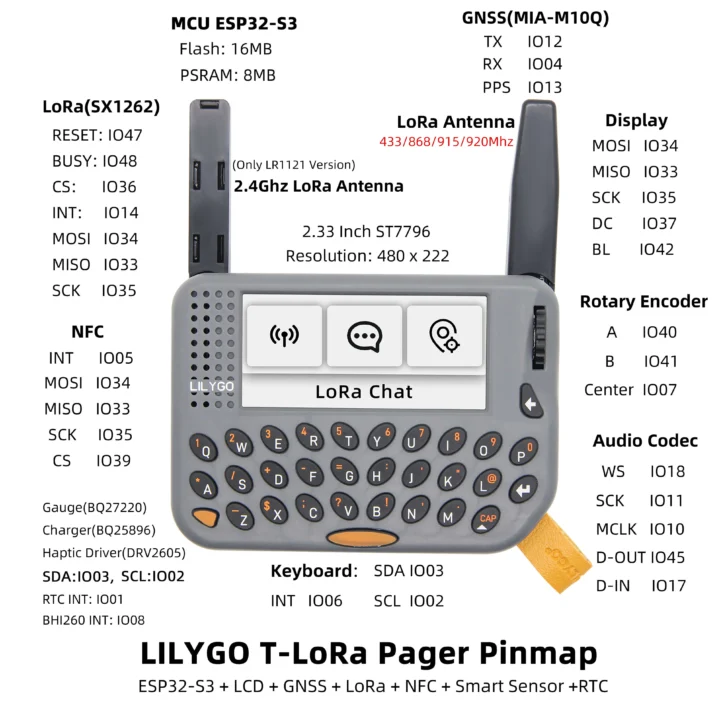 Lora Pager’s pinmap and functionalities
Lora Pager’s pinmap and functionalities
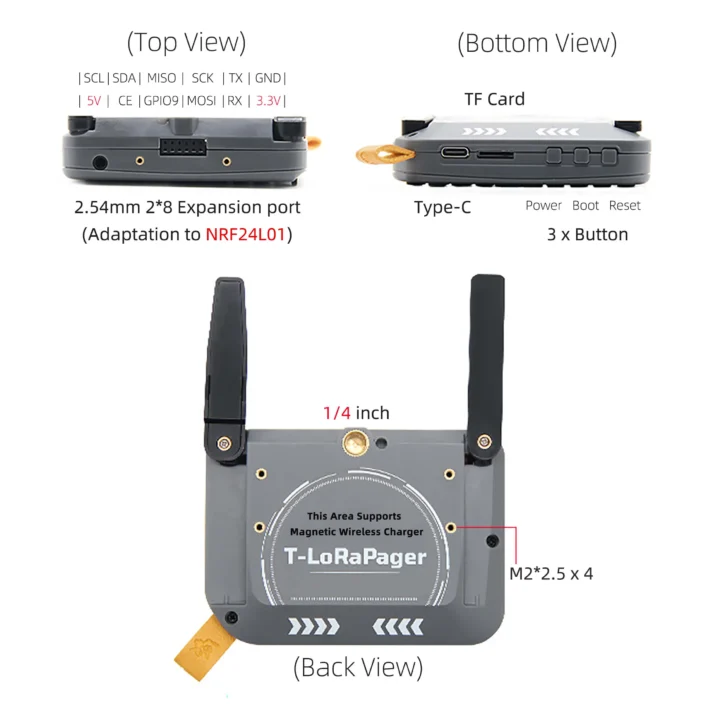 Lora Pager’s top, bottom, and back views
Lora Pager’s top, bottom, and back views
In terms of software, the device can be programmed with Arduino IDE, ESP-IDF, and Visual Studio Code. More information, along with a getting-started guide and hardware information, can be found on the product’s GitHub repository. The T-Lora Pager is also supported by third-party, open-source LoRa messaging firmware, such as ChatterBox. Meshtastic support might be coming soon, and somebody already ported it to MeshCore.
There are many LoRa-based communication devices now, and we covered other similar products such as the LILYGO T-Deck Pro handheld LoRa-based text messaging kit based on an ESP32-S3, MessengerPi 2-in-1 LoRa messenger and walkie-talkie based on the Raspberry Pi RP2040, and the LILYGO T3-S3 MVSR LoRa voice communication kit, which emulates the behavior of a Walkie-Talkie using Codec2 low-bitrate speech audio codec at 3200 bps using LoRa FSK modulation. Somebody also retrofitted a Nokia E63 phone into a LoRa messenger for secure, off-the-grid communication.
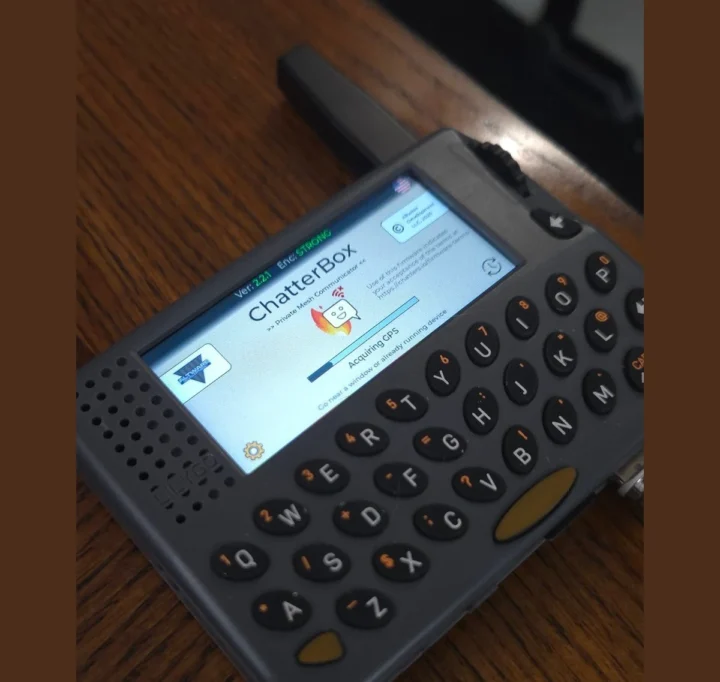 ChatterBox on the T-LoRa Pager
ChatterBox on the T-LoRa Pager
LILYGO first introduced the T-LoRa Pager a few months ago, but it quickly went out of stock (and still is on the company’s store). It’s been available on AliExpress from a few sellers at crazy prices ($170+) since then, but we’ve just noticed third-party sellers are now offering it for a little over $100 including shipping (but not eventual taxes). and it’s also sold on Banggood for $101.36. Four variants are available (433 MHz, 868 MHz, 915 MHz, and 920 MHz), so make sure to select the model that matches your country’s regulations.
Debashis Das is a technical content writer and embedded engineer with over five years of experience in the industry. With expertise in Embedded C, PCB Design, and SEO optimization, he effectively blends difficult technical topics with clear communication
Support CNX Software! Donate via cryptocurrencies, become a Patron on Patreon, or purchase goods on Amazon or Aliexpress. We also use affiliate links in articles to earn commissions if you make a purchase after clicking on those links.

